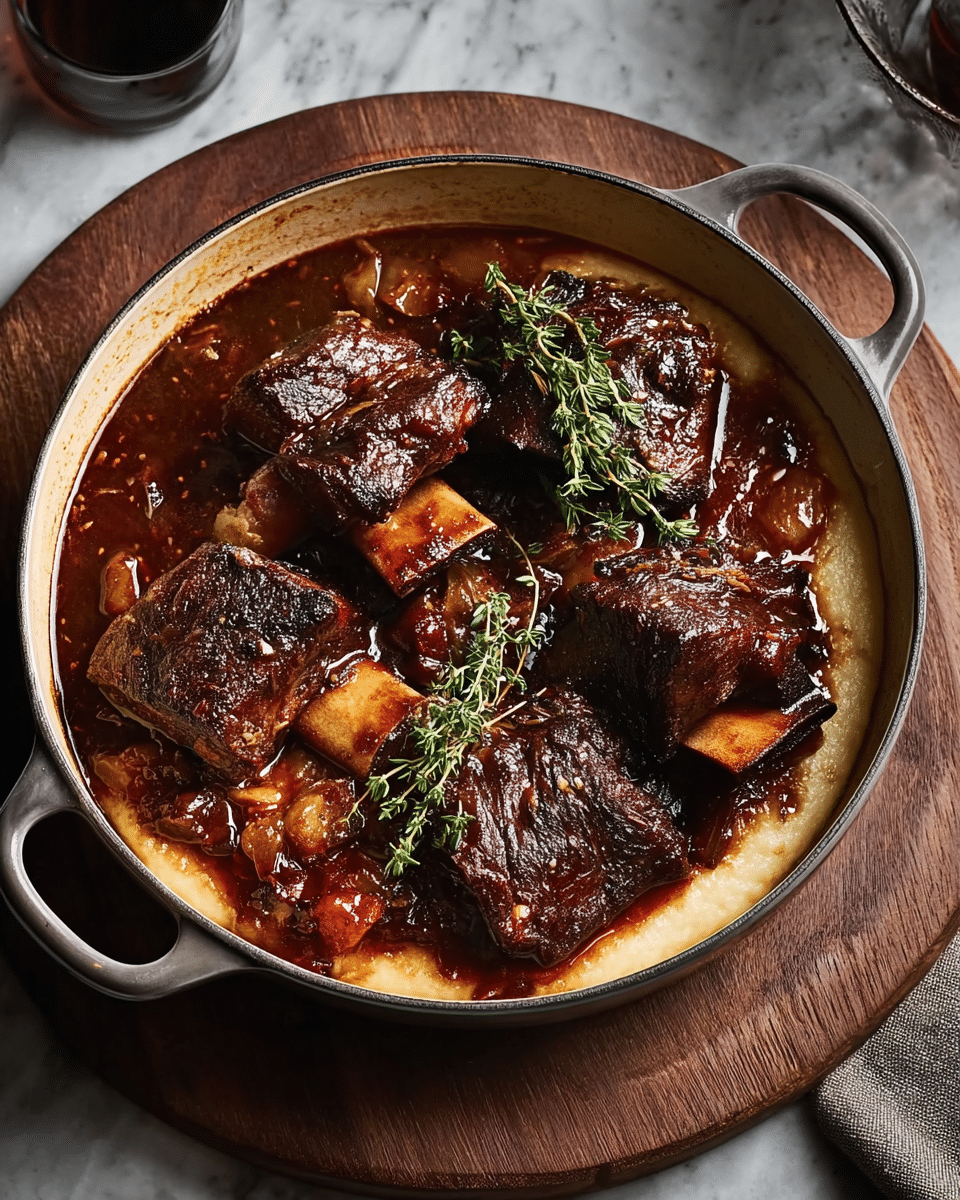Braised Short Ribs are the ultimate comfort food—rich, tender beef slow-cooked with vegetables, herbs, and wine until the meat falls off the bone. This low-and-slow cooking method transforms a tough cut into a luxurious, flavorful dish perfect for special occasions or cozy family dinners. The deeply savory sauce is ideal for spooning over mashed potatoes, polenta, or crusty bread.
Full Recipe:
Ingredients
-
4 lbs beef short ribs (bone-in for best flavor)
-
2 tbsp olive oil
-
1 onion, chopped
-
2 carrots, chopped
-
2 celery stalks, chopped
-
4 cloves garlic, minced
-
2 cups red wine (or beef broth)
-
4 cups beef broth
-
2 tbsp tomato paste
-
1 tsp dried thyme
-
2 bay leaves
-
Salt and pepper, to taste
-
Fresh parsley, for garnish
Directions
-
Preheat Oven
-
Set oven to 300°F (150°C).
-
-
Sear the Ribs
-
Season ribs with salt and pepper. Heat olive oil in a Dutch oven over medium-high heat and brown ribs on all sides (3–4 minutes per side). Remove and set aside.
-
-
Sauté Vegetables
-
Add onion, carrots, and celery to the pot; cook 5–7 minutes until softened. Stir in garlic and cook 1 more minute.
-
-
Add Liquid
-
Stir in red wine, scraping up browned bits from the bottom. Add beef broth, tomato paste, thyme, and bay leaves. Bring to a simmer.
-
-
Braise
-
Return ribs to the pot, cover, and transfer to oven. Cook for 3 hours or until meat is fork-tender.
-
-
Serve
-
Remove ribs, strain sauce, and skim off excess fat. Serve ribs with sauce and garnish with parsley.
-
Nutrients (per serving)
-
Calories: 450 kcal
-
Protein: 35 g
-
Fat: 30 g
-
Carbohydrates: 10 g
Why Braising Works Wonders
Braising is one of the oldest and most effective cooking methods for turning tough cuts into melt-in-your-mouth masterpieces. The process starts with searing the meat to lock in flavor, followed by slow cooking in a flavorful liquid. Over hours of gentle heat, the connective tissues break down, and the beef becomes incredibly tender while absorbing all the aromatics from the broth, wine, and vegetables. The result is a dish that’s as much about the sauce as it is about the meat.
The Star Ingredient: Beef Short Ribs
Beef short ribs are a cut taken from the lower part of the rib cage, with a balance of meat, fat, and bone that makes them perfect for braising. The bone adds richness to the sauce, while the marbling ensures the meat stays juicy through hours of cooking. Bone-in short ribs are often preferred for their deeper flavor, though boneless ribs can work in a pinch. The key is low-and-slow cooking, which allows the fat to render and the flavors to develop fully.
Building Layers of Flavor
The foundation of this dish is built in stages. First, the ribs are seared until they develop a golden-brown crust. This not only locks in juices but also creates browned bits in the pan—fond—that will enrich the sauce. Then come the vegetables: onions for sweetness, carrots for earthiness, and celery for depth. Garlic adds its distinctive aroma, and tomato paste brings a concentrated tang that rounds out the flavor profile.
The Role of Red Wine and Beef Broth
The braising liquid is where the magic happens. A combination of red wine and beef broth forms the base, creating a sauce that’s rich, balanced, and complex. Red wine adds acidity, which tenderizes the meat while lending deep, fruity undertones. Beef broth enhances the savory element, ensuring the sauce is full-bodied. As the dish cooks, these liquids mingle with the juices from the meat and the caramelized vegetables, becoming something truly irresistible.
Herbs and Aromatics for Depth
Herbs and aromatics are essential in giving the dish its distinctive character. Thyme provides a subtle, earthy herbal note, while bay leaves add a hint of floral bitterness that balances the richness. These flavors develop gradually during the slow cooking process, infusing the meat and sauce with complexity. A garnish of fresh parsley at the end brightens the dish, cutting through the richness with a burst of freshness.
Why Low-and-Slow Cooking Is Essential
Short ribs need time—there’s no rushing the process if you want them to be tender and flavorful. Cooking them at a low temperature for several hours allows the connective tissue to dissolve, leaving meat that falls off the bone with just a fork. This gentle method also prevents the meat from drying out, as the moist cooking environment keeps everything juicy.
A Sauce Worth Savoring
By the time the ribs are done, the braising liquid has transformed into a velvety sauce, enriched with the essence of beef, vegetables, and wine. Straining the sauce gives it a smooth texture, and skimming off the excess fat ensures it’s indulgent without being greasy. This sauce is so flavorful that it’s worth serving with something that can soak it up—mashed potatoes, polenta, or a crusty loaf of bread are all perfect companions.
Perfect for Make-Ahead Meals
One of the hidden benefits of braised short ribs is how well they reheat. In fact, many cooks believe they taste even better the next day, after the flavors have had time to meld. This makes them an excellent choice for entertaining—you can prepare them a day ahead, store them in the fridge, and simply reheat before serving. The extra time also makes it easier to remove any solidified fat from the sauce, resulting in a cleaner, more refined dish.
Pairing Ideas
Braised short ribs pair beautifully with a variety of sides and drinks. Creamy mashed potatoes are a classic choice, as they soak up the sauce beautifully. Polenta offers a slightly lighter option, with its creamy texture complementing the rich meat. Roasted root vegetables or sautéed greens add color and balance to the plate. For drinks, a bold red wine like Cabernet Sauvignon or Merlot echoes the flavors in the braising liquid, while a dark ale provides a hearty alternative.
Tips for the Best Results
To get the most flavor, take your time with the searing step—don’t crowd the pan, and let the ribs develop a deep brown crust. When adding the wine, scrape up every browned bit from the bottom of the pot, as these are packed with flavor. If you prefer a thicker sauce, you can reduce it further on the stovetop after removing the ribs. Finally, taste the sauce before serving and adjust the seasoning as needed; the long cooking time can mellow flavors, so a final pinch of salt or dash of pepper may be just what it needs.
A Dish That Feels Special
Braised short ribs are versatile enough to serve for a cozy family dinner or a formal celebration. Their presentation—meaty ribs resting in a pool of rich, glossy sauce—makes them look like something straight from a fine dining menu. Yet, they’re also the kind of food you want to enjoy in big, comforting bites, ideally with friends and family gathered around the table.
Nutritional Highlights
While undeniably rich, braised short ribs also deliver a solid serving of protein and essential nutrients like iron and zinc. The vegetables in the sauce contribute vitamins and minerals, while the slow cooking method keeps added fats to a minimum. Portion control is key here—a little goes a long way, especially when served with hearty sides.
Why This Recipe Endures
Braised short ribs are a classic for a reason. They represent the best of what slow cooking can offer: a transformation of humble ingredients into something luxurious. The process is simple but rewarding, with every step adding another layer of flavor. Once you’ve made them, you’ll see why they’ve been a staple of comfort cooking for generations.
Conclusion
Braised short ribs are more than just a meal—they’re an experience. From the savory aroma that fills the kitchen during their slow cook to the first fork-tender bite, they deliver comfort, flavor, and a sense of occasion. The combination of tender beef, rich sauce, and perfectly balanced aromatics makes them a dish worth savoring, whether you’re marking a special event or simply indulging in a quiet night at home. Paired with creamy sides and a good glass of wine, they’re the ultimate answer to the question: “What should we make for a truly memorable dinner?”

